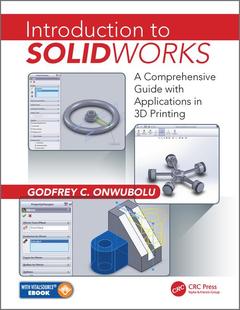Description
Introduction to SolidWorks
A Comprehensive Guide with Applications in 3D Printing
Author: Onwubolu Godfrey C.
Language: English
Subjects for Introduction to SolidWorks:
Keywords
Mid Plane; Additive Manufacturing; STL Model; CAD; STL File; Computer-aided Design; Cad Software; CNC; SolidWorks Simulation; Computer Numerical Control; SolidWorks Part Document; Cad Model; FeatureManager Design Tree; Edge Flange; Top Plane; Sketching Mode; Direction1 Rollout; Extrude PropertyManager; SolidWorks Solution; Fortus Machine; Extrude Cut; SolidWorks Assembly Document; Convert Entities Tool; Sheet Metal Part; Task Pane; Hole Wizard; Base Flange; Exit Sketch; Extrusion Depth; Bevel Gears
· 21x28 cm · Hardback
Description
/li>Contents
/li>Biography
/li>
This senior undergraduate level textbook is written for Advanced Manufacturing, Additive Manufacturing, as well as CAD/CAM courses. Its goal is to assist students in colleges and universities, designers, engineers, and professionals interested in using SolidWorks as the design and 3D printing tool for emerging manufacturing technology for practical applications. This textbook will bring a new dimension to SolidWorks by introducing readers to the role of SolidWorks in the relatively new manufacturing paradigm shift, known as 3D-Printing which is based on Additive Manufacturing (AM) technology.
This new textbook:
- Features modeling of complex parts and surfaces
- Provides a step-by-step tutorial type approach with pictures showing how to model using SolidWorks
- Offers a user-Friendly approach for the design of parts, assemblies, and drawings, motion-analysis, and FEA topics
- Includes clarification of connections between SolidWorks and 3D-Printing based on Additive Manufacturing
- Discusses a clear presentation of Additive Manufacturing for Designers using SolidWorks CAD software
"Introduction to SolidWorks: A Comprehensive Guide with Applications in 3D Printing" is written using a hands-on approach which includes a significant number of pictorial descriptions of the steps that a student should follow to model parts, assemble parts, and produce drawings.
Introduction; Geometric Construction Tools; Features; Part Modeling—CSWA Preparations; Advanced Part Modeling—CSWA Preparations; Creating Revolved, Swept, and Lofted Parts; Part Modeling with Equation-Driven Curves; Assembly Modeling—CSWA Preparations; Part and Assembly Drawings—CSWA Preparations; Reverse Engineering Using Auto Trace and FeatureWorks; Top–Down Design; Surface Modeling; Toolboxes and Design Libraries; Animation with Basic Motion; Animation with SolidWorks Motion; Rendering; Mold Design; Sheet Metal Parts—I; Sheet Metal Parts—II; Weldments; Routings in Piping and Tubing; Power Transmission Elements; Cam Design; Mechanism Design Using Blocks; Die Design; Aluminum Extrusion from Manufacturers’ Internet Websites; Geneva Wheel Mechanism; Event-Based Motion Analysis; Electrical Routing; Customized Internal and External Threads; Sustainability Design for Parts; Geometric Dimensioning and Tolerancing; Evaluating the Cost of Machined Parts; Finite Element Analysis Using SolidWorks; Overview of Additive Manufacturing; Insight Software for Fortus Production Systems; CatalystEX Software User Guide for Dimension sst 1200es; Bead Design with Orientation Considerations; Building Tall Parts Using Surround Support; Vacuum Forming; Design for Assembly Manufacturing; Design Guidelines for Advanced Build Options; Design for Functionality; Mold Tooling Using Z-Corp Spectrum 510 3D Printer
Godfrey Onwubolu holds BEng (University of Benin) and MSc degree in Mechanical Engineering (Aston University) and PhD degree in computer-aided design (CAD) (Aston University). His industrial experience is in manufacturing engineering in West Midlands, England. He was a consultant to a center of innovation for enabling small-to-medium enterprises, SMEs in the manufacturing sector. He works mainly in three areas: computer-aided design (CAD), advanced manufacturing (AM), and inductive modeling (IM). One of his textbooks in CAD is heavily used in many North American Universities and Colleges while the other is listed by the publishers, Imperial College Press, London as one of the top-10 bestsellers. He currently works in the area of Additive Manufacturing (AM) popularly known as 3D Printing where he continues to investigate the functionality of additive manufactured parts based on machine input parameters, in order to make users understand the characteristics of Additive Manufacturing Technologies. He is internationally recognized for his work in inductive modeling (IM) especially in Europe where he gives public lectures and examines doctoral theses in the area in Universities; and he is currently the Lead Researcher here at Sheridan in applying this technology to the joint Sheridan-Nexflow project for studying the behaviors of Nexflow air products based on their operational parameters. He has authored over 140 papers in international journals/conference proceedings and at least 10 textbooks. For several years he has been serving on the International Program Committee for Inductive Modeling Conference, Europe. He is currently on the Editorial Boards of International Journal of Manufacturing Engineering; and Production Planning & Control. He continues to use his expertise in the domains of CAD, AM, and IM of his career as an engineering and technology educator to impact knowledge to students, and to advance productivity in the manufacturing industry sector in Can




